How to remove the Cerberus banking Trojan
![]() Written by Tomas Meskauskas on (updated)
Written by Tomas Meskauskas on (updated)
What kind of malware is Cerberus?
Cerberus is an Android banking Trojan which can be rented on hacker forums. It was been created in 2019 and is used to steal sensitive, confidential information. Cerberus can also be used to send commands to users' devices and perform dangerous actions.
Typically, cyber criminals behind banking Trojans such as Cerberus attempt to gain access to information, which could be misused to generate revenue.
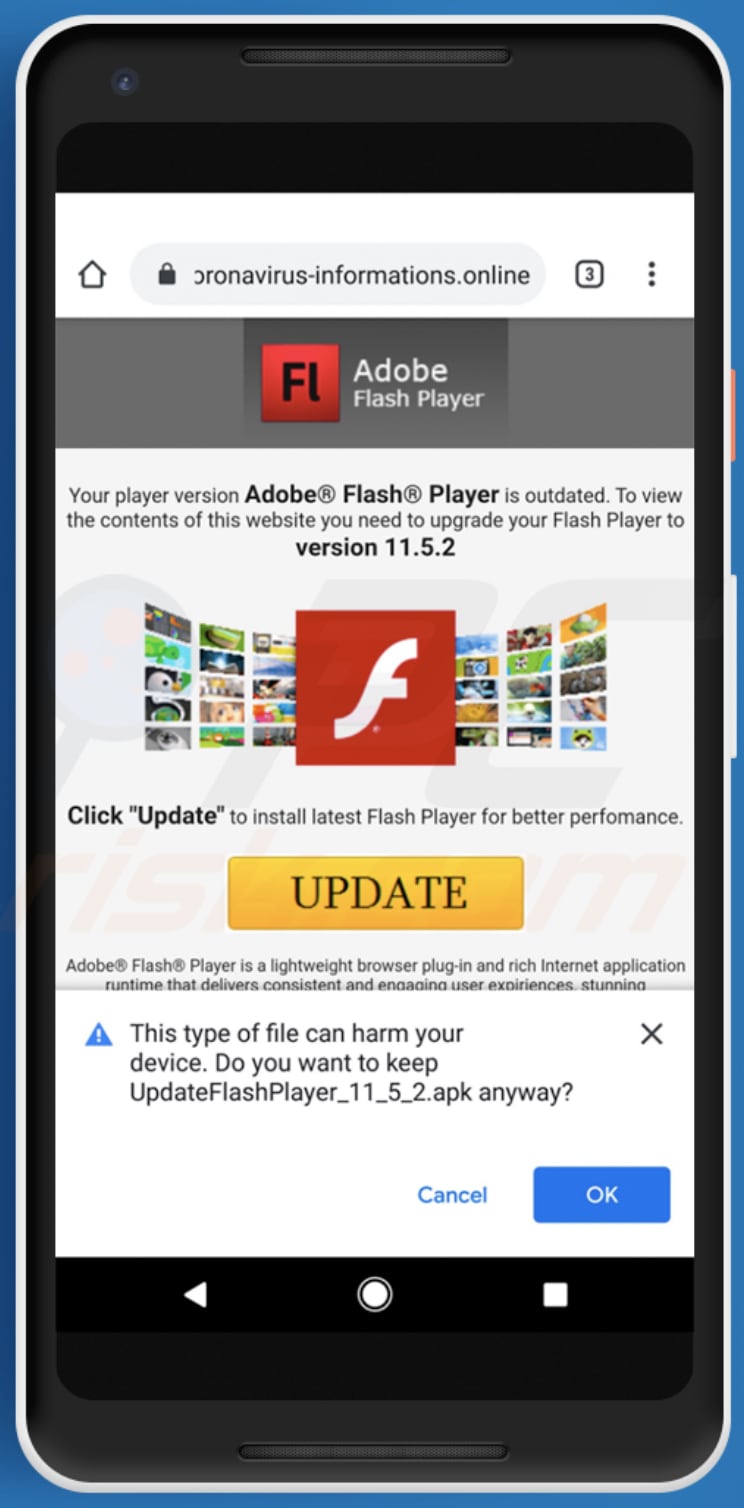
Cerberus malware overview
Cerberus is disguised as a Flash Player application or a service, which does not appear in the application drawer. It attempts to deceive users into providing increased privileges through the Accessibility Service. If those privileges are granted, Cerberus is connected to a botnet and can receive commands from a Command & Control (C2) server.
Cyber criminals behind Cerberus can use it to perform various actions on the victim's device.
For example, as a keylogger, to acquire the list of installed apps, access contacts (names and numbers), enable call forwarding to a particular number, display push notifications that, if clicked, launch a specific app, start applications, delete them, send text messages, open addresses in WebView, lock the screen, and other dangerous tasks.
Furthermore, this banking Trojan is capable of performing 'overlay attacks', which can be used to deceive victims into providing confidential information such as credit card details, banking, email credentials, and other sensitive details. In summary, Cerberus can operate as a credentials stealer and credit card grabber.
Confidential information is stolen when victims enter their login credentials or credit card details on overlays that may seem to be legitimate login and banking sites. The details are then sent to the attacker's C2 server.
Research shows that, at the time of research, Cerberus can be used to perform overlay attacks several French, U.S., and one Japanese banking app, and fifteen non-banking applications.
| Name | Cerberus banking malware |
| Threat Type | Android malware, malicious application, banking Trojan. |
| Detection Names | Avast (Android:Cerberus-L [Bank]), AVG (Android:Cerberus-L [Bank]), ESET-NOD32 (A Variant Of Android/TrojanDropper.Agent.EQH), Kaspersky (HEUR:Trojan-Dropper.AndroidOS.Hqwar.bz), Full List (VirusTotal) |
| Related Domain | coronavirus-informations[.]online, canada-alert-covid19[.]com |
| Symptoms | The device is running slowly, system settings are modified without users' permission, dubious applications appear, data and battery usage is increased significantly, browsers redirect to rogue websites, intrusive advertisements are delivered. |
| Distribution methods | Infected email attachments, malicious online advertisements, social engineering, deceptive applications, scam websites. |
| Damage | Stolen personal information (private messages, logins/passwords, etc.), decreased device performance, battery is drained quickly, decreased internet connection speed, large data losses, monetary losses, stolen identity (malicious apps might abuse communication apps). |
| Malware Removal (Android) | To eliminate possible malware infections, scan your mobile device with legitimate antivirus software. Our security researchers recommend using Combo Cleaner. |
Cyber criminals behind banking Trojans such as Cerberus attempt to steal information that could be used to make fraudulent purchases, transactions, hijack various accounts, send fraudulent text messages, etc. People with devices infected by Cerberus can become victims of identity theft, suffer monetary loss, experience online privacy issues, and suffer other serious problems.
How did Cerberus infiltrate my device?
Research shows that Cereberus banking malware has recently been promoted through fake Flash Players (the installers) and coronavirus-related domains (malicious websites such as coronavirus-informations[.]online). Cyber criminals commonly disguise malicious programs using names of legitimate applications such as Adobe Flash Player.
Typically, they are promoted on unofficial, deceptive pages (in this case, on pages with coronavirus-related domains) and are not associated to the official versions. Note that the deceptive web pages attempt to trick visitors into using fake Adobe Flash Player (and other) installers by claiming that the installed version is out of date.
How to avoid installation of malware
Software and files should be downloaded from official websites and through direct links. Other channels, such as unofficial, dubious sites, third party downloaders, Peer-to-Peer networks, freeware download pages, free file hosting sites, etc. can proliferate malicious programs.
Third party, fake installers often spread malware. Furthermore, attachments and website links in irrelevant emails that are received from unknown, suspicious addresses should not be opened without being sure that it is safe to do so. Installed software must be updated and activated (if necessary) with tools/functions that are provided by official developers.
Various 'cracking' tools (unofficial activation programs) can install malicious software. Furthermore, it is illegal to activate licensed programs with these tools. Keep operating systems safe by regularly scanning them for threats with reputable antivirus or anti-spyware software.
Another deceptive website (canada-alert-covid19[.]com) used to spread the Cerberus Trojan:
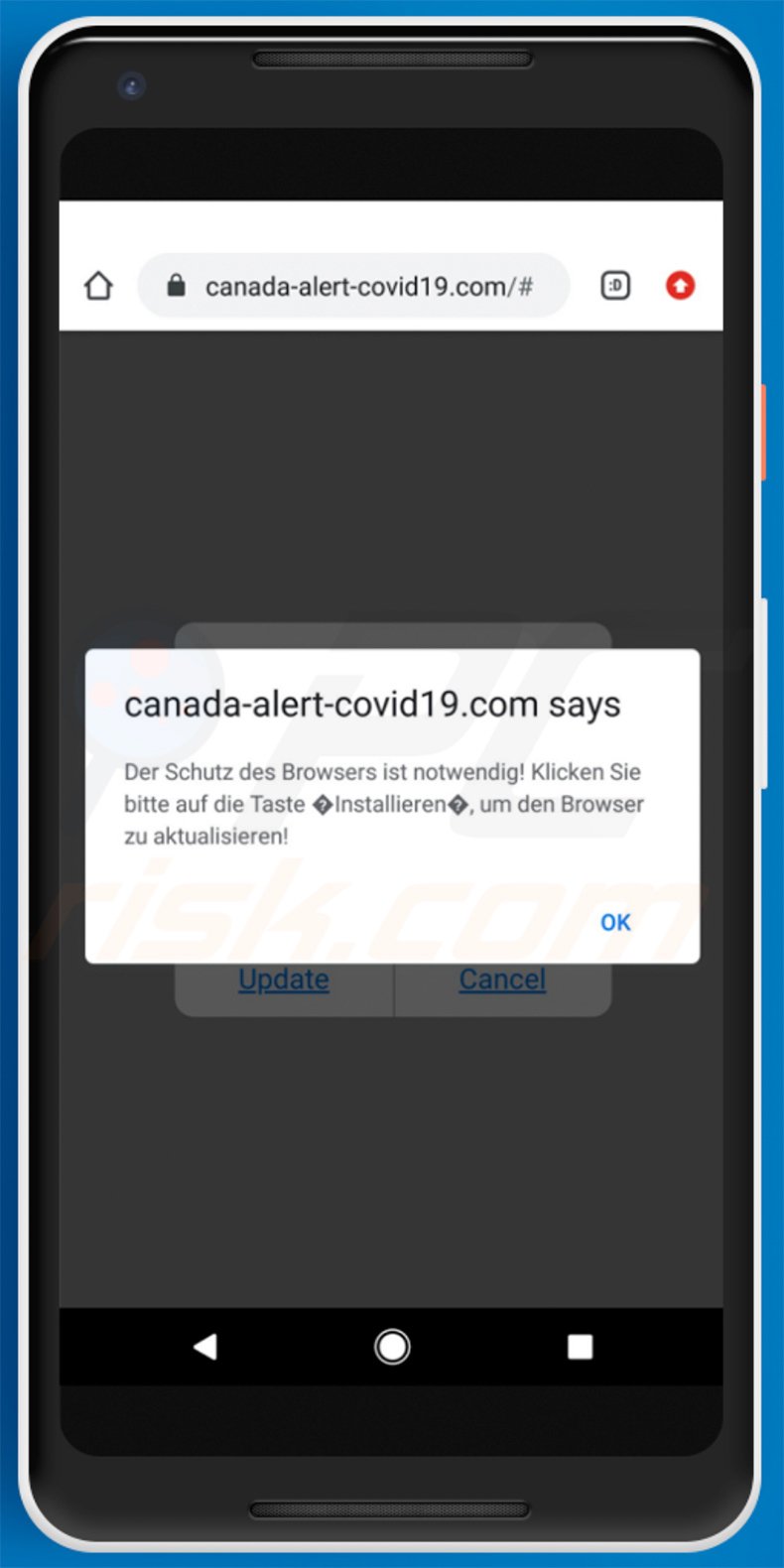
Yet another deceptive website (chromedownload[.]club) used to distribute Cerberus by presenting it as a Google Chrome update:
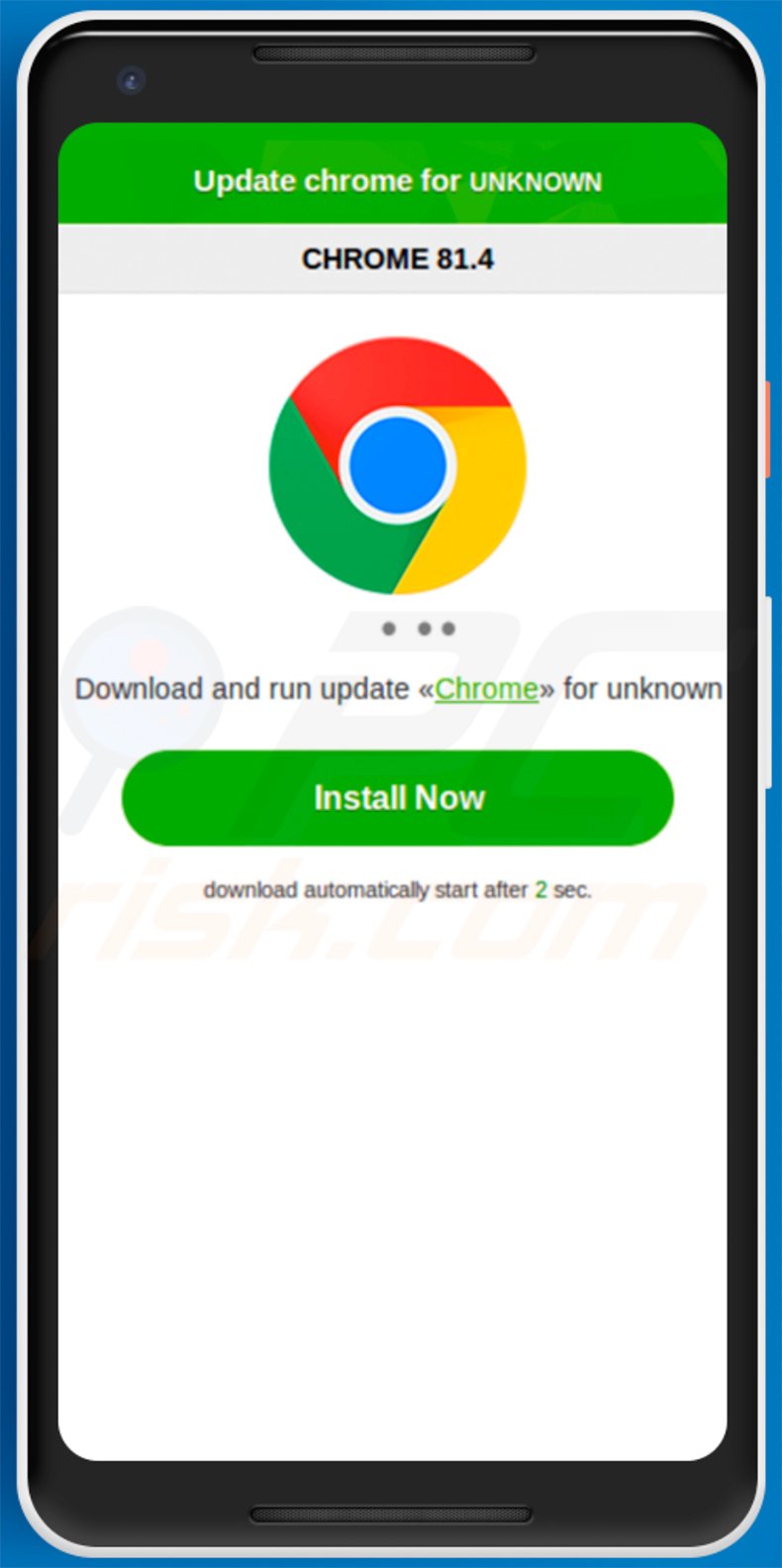
Yet another deceptive website (chromedownload[.]website) used to distribute Cerberus by presenting it as a Google Chrome update:
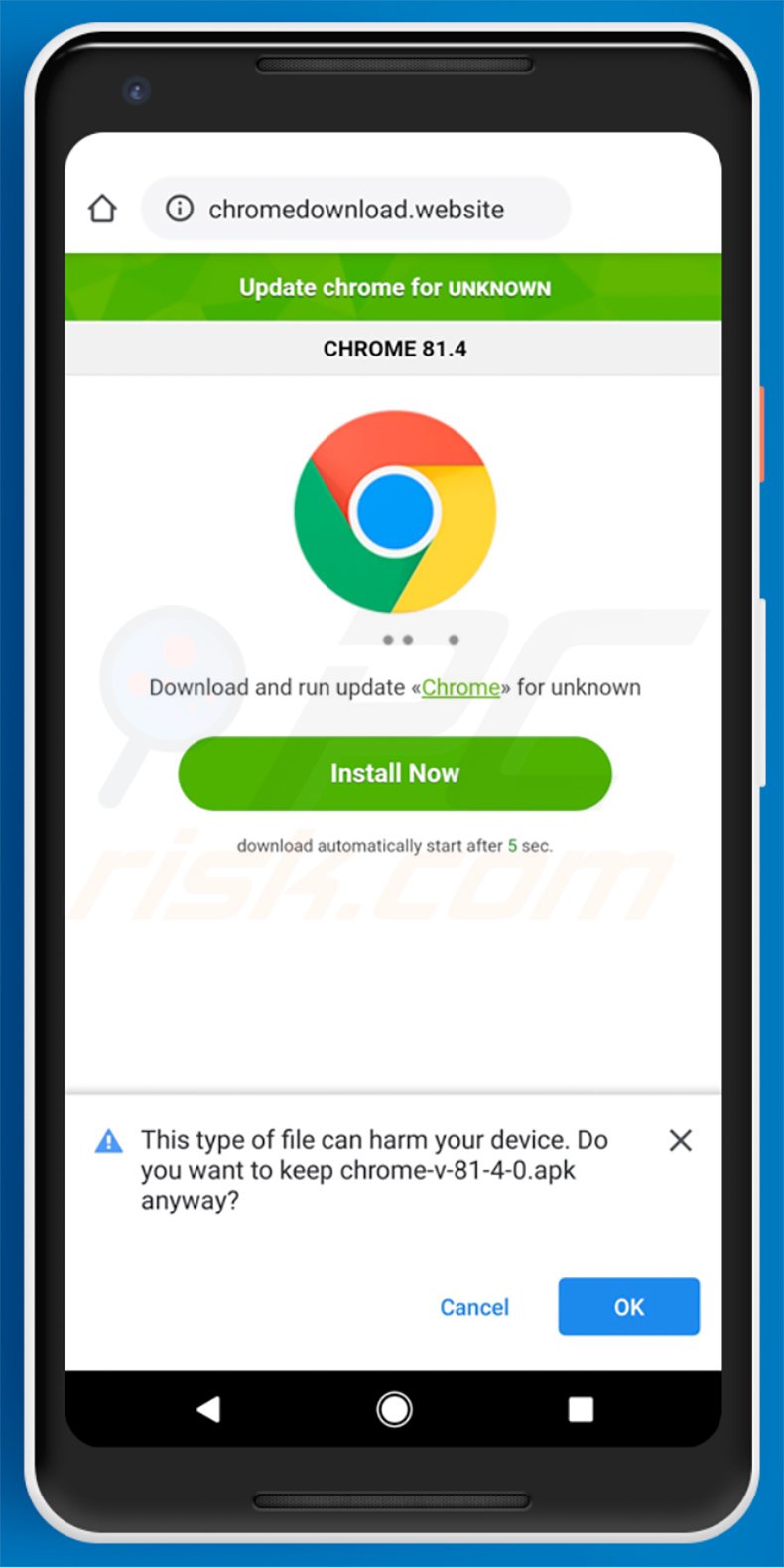
Screenshot of a malicious website (bigbitwallet[.]com) promoting the Cerberus banking Trojan:

Yet another malicious website (cdph-ca[.]us) used to spread the Cerberus banking Trojan:

Another website ("safety-guidelines[.]online") used to promote the Cerberus banking Trojan by presenting it as an Adobe Flash Player updater:
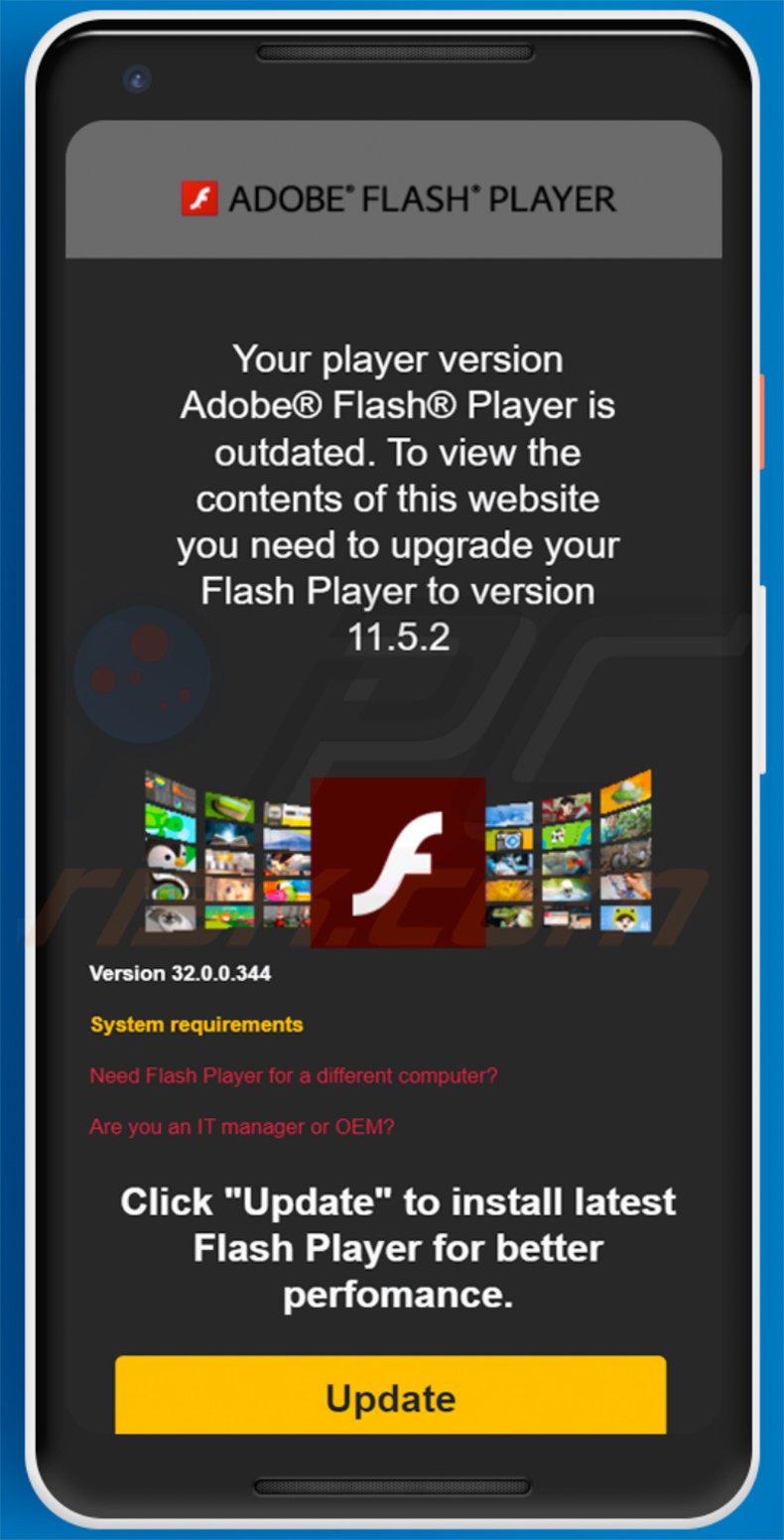
List of apps targeted by Cerberus malware (it may expand):
- Bank of America Mobile Banking
- Banque
- Banque Populaire
- Boursorama Banque
- Capital One® Mobile
- Chase Mobile
- Connect for Hotmail
- Fifth Third Mobile Banking
- Gmail
- imo free video calls and chat
- ING
- L'Appli Société Générale
- Ma Banque
- Mail (Android)
- Mes Comptes BNP Paribas
- Microsoft Outlook
- Play Market
- Snapchat
- Telegram
- U.S. Bank - Inspired by customers
- USAA Mobile
- Uber
- Viber
- Wells Fargo Mobile
- Yahoo Mail – Organized Email
Quick menu:
- Introduction
- How to delete browsing history from the Chrome web browser?
- How to disable browser notifications in the Chrome web browser?
- How to reset the Chrome web browser?
- How to delete browsing history from the Firefox web browser?
- How to disable browser notifications in the Firefox web browser?
- How to reset the Firefox web browser?
- How to uninstall potentially unwanted and/or malicious applications?
- How to boot the Android device in "Safe Mode"?
- How to check the battery usage of various applications?
- How to check the data usage of various applications?
- How to install the latest software updates?
- How to reset the system to its default state?
- How to disable applications that have administrator privileges?
Delete browsing history from the Chrome web browser:

Tap the "Menu" button (three dots on the right-upper corner of the screen) and select "History" in the opened drop-down menu.

Tap "Clear browsing data", select "ADVANCED" tab, choose the time range and data types you want to delete and tap "Clear data".
Disable browser notifications in the Chrome web browser:

Tap the "Menu" button (three dots on the right-upper corner of the screen) and select "Settings" in the opened drop-down menu.

Scroll down until you see "Site settings" option and tap it. Scroll down until you see "Notifications" option and tap it.

Find the websites that deliver browser notifications, tap on them and click "Clear & reset". This will remove permissions granted for these websites to deliver notifications, however, if you visit the same site again, it might ask for permission again.
You can choose whether to give these permissions or not (if you choose to decline, the website will go to the "Blocked" section and will no longer ask for permission).
Reset the Chrome web browser:

Go to "Settings", scroll down until you see "Apps" and tap it.

Scroll down until you find "Chrome" application, select it and tap "Storage" option.

Tap "MANAGE STORAGE", then "CLEAR ALL DATA" and confirm the action by taping "OK". Note that resetting the browser will eliminate all data stored within. Therefore, all saved logins/passwords, browsing history, non-default settings and other data will be deleted. You will also have to login into all websites again.
Delete browsing history from the Firefox web browser:

Tap the "Menu" button (three dots on the right-upper corner of the screen) and select "History" in the opened drop-down menu.

Scroll down until you see "Clear private data" and tap it. Select data types you want to remove and tap "CLEAR DATA".
Disable browser notifications in the Firefox web browser:

Visit the website that is delivering browser notifications, tap the icon displayed on the left of URL bar (the icon will not necessarily be a "Lock") and select "Edit Site Settings".

In the opened pop-up, opt-in to the "Notifications" option and tap "CLEAR".
Reset the Firefox web browser:

Go to "Settings", scroll down until you see "Apps" and tap it.

Scroll down until you find "Firefox" application, select it and tap "Storage" option.

Tap "CLEAR DATA" and confirm the action by taping "DELETE". Note that resetting the browser will eliminate all data stored within. Therefore, all saved logins/passwords, browsing history, non-default settings and other data will be deleted. You will also have to login into all websites again.
Uninstall potentially unwanted and/or malicious applications:

Go to "Settings", scroll down until you see "Apps" and tap it.

Scroll down until you see a potentially unwanted and/or malicious application, select it and tap "Uninstall". If, for some reason, you are unable to remove the selected app (e.g., you are prompted with an error message), you should try using the "Safe Mode".
Boot the Android device in "Safe Mode":
The "Safe Mode" in Android operating system temporarily disables all third-party applications from running. Using this mode is a good way to diagnose and solve various issues (e.g., remove malicious applications that prevent you from doing so when the device is running "normally").

Push the "Power" button and hold it until you see the "Power off" screen. Tap the "Power off" icon and hold it. After a few seconds the "Safe Mode" option will appear and you'll be able run it by restarting the device.
Check the battery usage of various applications:

Go to "Settings", scroll down until you see "Device maintenance" and tap it.

Tap "Battery" and check the usage of each application. Legitimate/genuine applications are designed to use as little energy as possible to provide the best user experience and save power. Therefore, high battery usage might indicate that the application is malicious.
Check the data usage of various applications:

Go to "Settings", scroll down until you see "Connections" and tap it.

Scroll down until you see "Data usage" and select this option. As with the battery, legitimate/genuine applications are designed to minimize data usage as much as possible. Therefore, significant data usage might indicate presence of a malicious application.
Note that some malicious applications might be designed to operate when the device is connected to a wireless network only. For this reason, you should check both Mobile and Wi-Fi data usage.

If you find an application that uses significant data even though you never use it, we strongly advise you to uninstall it immediately.
Install the latest software updates:
Keeping software up to date is a good practice for device safety. The device manufacturers are continually releasing various security patches and Android updates to fix errors and bugs, which can be abused by cyber criminals. An outdated system is much more vulnerable, and thus you should always ensure that your device software is up to date.

Go to "Settings", scroll down until you see "Software update" and tap it.

Tap "Download updates manually" and check if there are any updates available. If so, install them immediately. We also recommend that you enable the "Download updates automatically" option - this will allow the system to notify you when an update is released and/or install it automatically.
Reset the system to its default state:
Performing a "Factory Reset" is a good way to remove all unwanted applications, restore system settings to their default values, and clean the device in general. Also bear in mind that all data within the device will be deleted, including photos, video/audio files, phone numbers (stored within the device, not the SIM card), SMS messages, and so on.
I.e., the device will be restored to its initial/factory state.
You can also restore the basic system settings or simply network settings.

Go to "Settings", scroll down until you see "About phone" and tap it.

Scroll down until you see "Reset" and tap it. Now choose the action you want to perform:
"Reset settings" - restore all system settings to default;
"Reset network settings" - restore all network-related settings to default;
"Factory data reset" - reset the entire system and completely delete all stored data;
Disable applications that have administrator privileges:
If a malicious application receives administrator-level privileges, it can seriously damage the system. To keep the device as safe as possible, you should always check which apps have such privileges and disable those that should not.

Go to "Settings", scroll down until you see "Lock screen and security" and tap it.

Scroll down until you see "Other security settings", tap it and then tap "Device admin apps".

Identify applications that should not have administrator privileges, tap them and then tap "DEACTIVATE".
Frequently Asked Questions (FAQ)
My Android device is infected with Cerberus malware, should I format my storage device to get rid of it?
Malware removal rarely requires formatting.
What are the biggest issues that Cerberus malware can cause?
The dangers associated with an infection depend on the malware's capabilities and the attackers' goals. Cerberus targets sensitive data, particularly information relating to finances and banking. Generally, infections of his kind can lead to severe privacy issues, financial losses, and even identity theft.
What is the purpose of Cerberus malware?
Malware is usually utilized to generate revenue, and Cerberus' functionalities suggest this use. It is pertinent to mention that malicious software can also be used to amuse the attacks, carry out personal grudges, disrupt processes (e.g., websites, services, companies, organizations, etc.), and even launch politically/geopolitically motivated attacks.
How did Cerberus malware infiltrate my Android device?
Cerberus malware has been observed being spread via malicious pages wearing various disguises, including but not limited to software updates, news on the COVID-19 pandemic, and cryptocurrency wallets.
However, Cerberus could be spread using other techniques. Aside from scam sites, other common malware distribution methods include spam mail, malvertising, dubious download channels (e.g., freeware and free file-hosting websites, Peer-to-Peer sharing networks, etc.), illegal software activation ("cracking") tools, and fake updates.
Will Combo Cleaner protect me from malware?
Yes, Combo Cleaner is designed to scan devices and eliminate all manner of threats. It is capable of detecting and removing practically all known malware infections. Note that running a full system scan is paramount since high-end malicious software typically hides deep within systems.


▼ Show Discussion